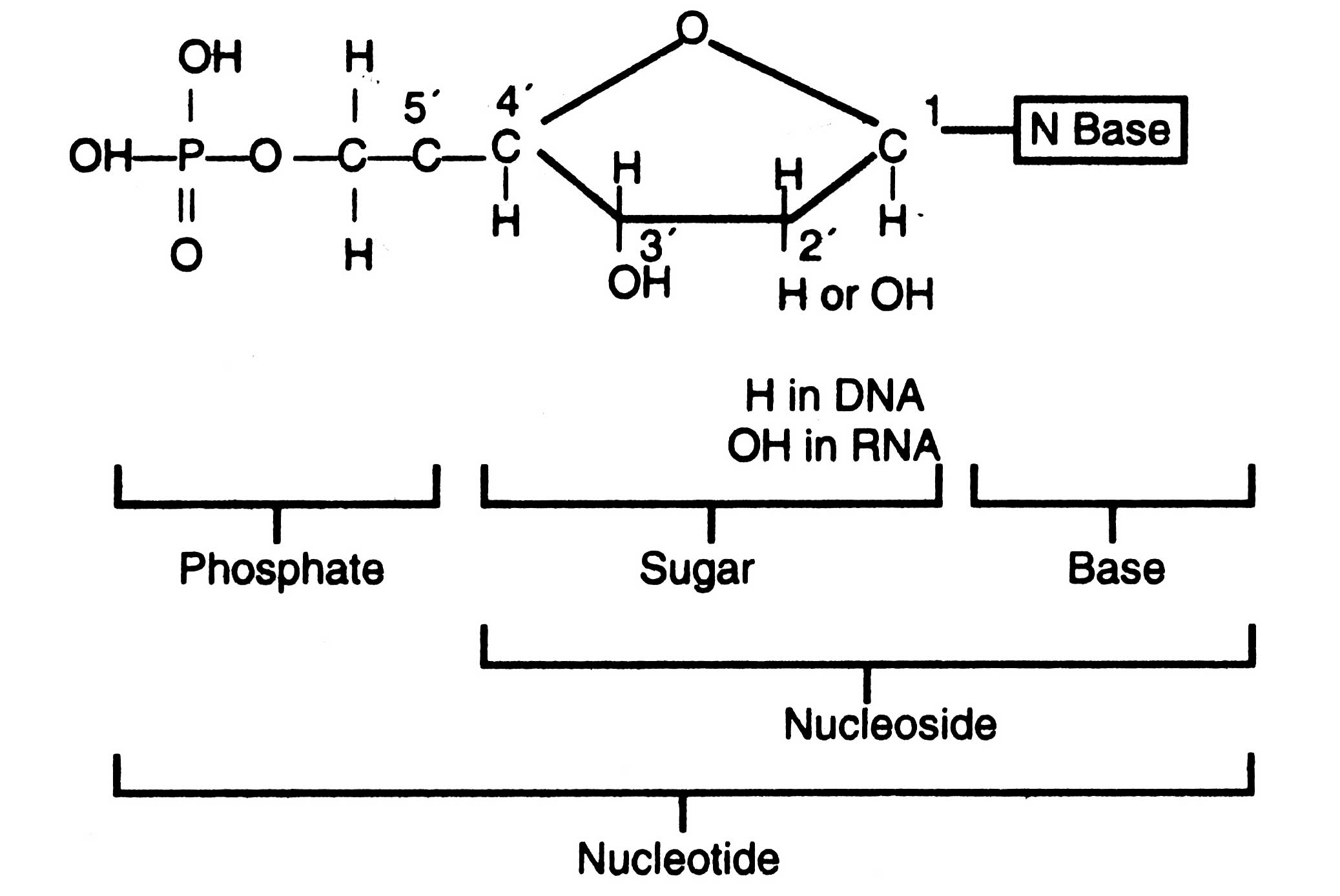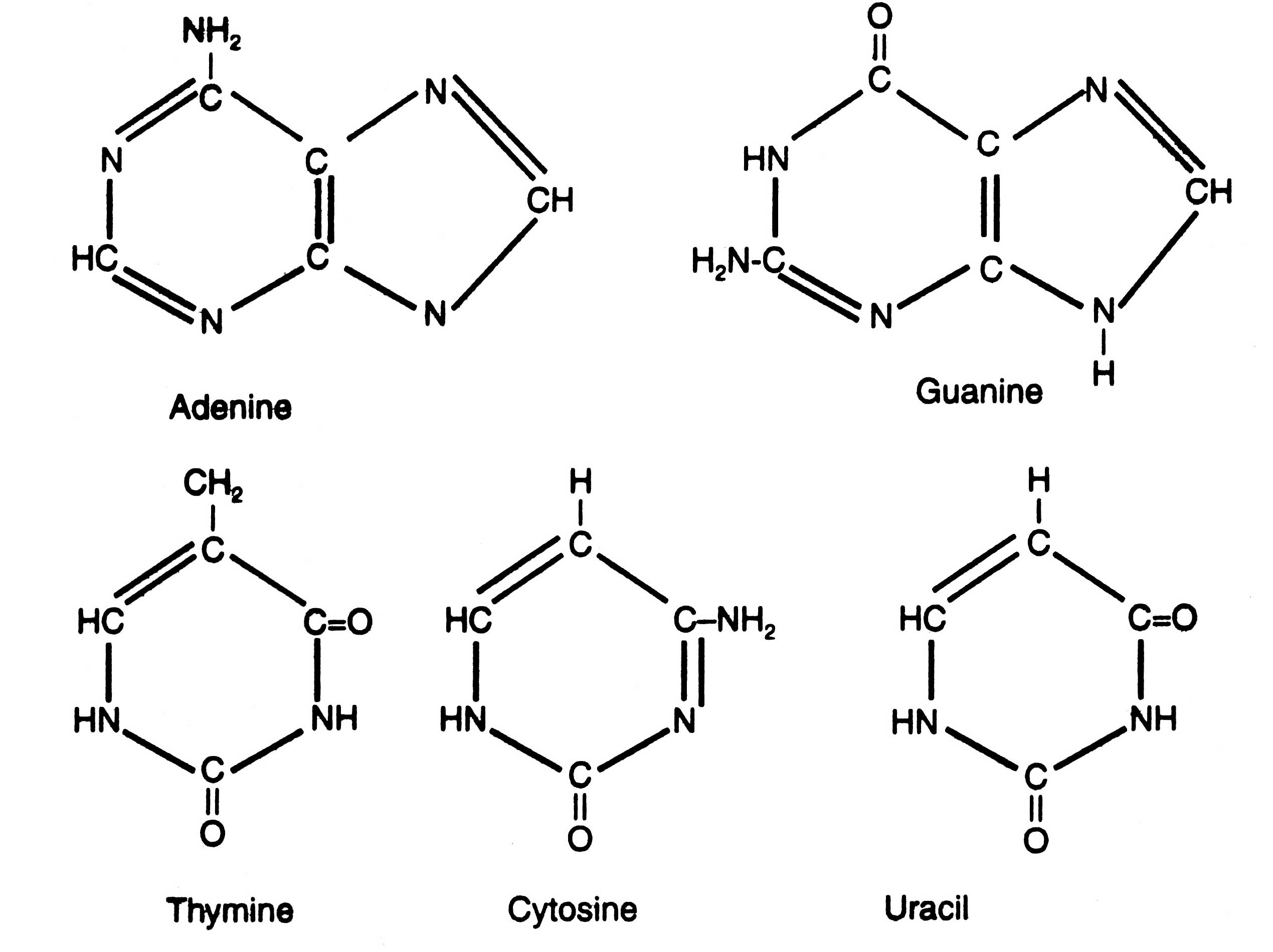Chemical Nature of DNA
Purified DNA isolated from a variety of plants, animals, bacteria and viruses has shown a complex form of polymeric compounds containing four monomers known as deoxyribonucleotide monomers or deoxyribotids (Fig.1). Each deoxyribonucleotide consists of pentose sugar (deoxyribose), a phosphate group and a nitrogenous base (either purine or pyrimidine). Purines bases (adenine and guanine) are heterocyclic and two ringed bases and the pyrimidines (thymine and cytosine) are one ringed bases. The following components of deoxyribonucleotide have been described:
(i) A five carbon ring. Deoxyribose is a pentose sugar consisting of five carbon atoms. Four carbon atoms (1', 2', 3', 4') of this sugar combine with one oxygen atom and form a ring. The fifth atom (5') forms -CH2 group which is present outside this ring. Three -OH groups are attached at position 1', 3' and 5' and the hydrogen atoms combine at position 1', 2', 3' and 4' of carbon atoms (Fig.1). In ribonucleotides, the pentose sugar is ribose which is similar to deoxyribose except that there is an -OH group instead of -H at 2' carbon atom. The absence of -OH group in DNA makes it chemically more stable than the RNA.
Table 1. Nature of genetic material.
| DNA/RNA | Examples |
| Double stranded DNA (dsDNA) | Higher plants, animals, bacteria, animal viruses (polyoma virus, small pox, herpes virus), Bacteriophages (T-even) |
| Single stranded DNA (ssDNA) | Bacteriophages ($ XI74 and other bacteriophages), Animal viruses (parvovirus) |
| Double stranded RNA (dsRNA) virus | Retrovirus, Reovirus, Hepatitis-B virus, animal virus |
| Single stranded RNA (ssRNA) | Plant viruses (tobacco mosaic virus)Animal viruses (influenza virus, poliomyelitis virus)Bacteriophages ( F2, ~ R17) |
The nitrogenous bases combined with pentose sugar are called nucleosides. A nucleoside linked with phosphate forms a nucleotide (Fig.1).
Nucleoside = pentose sugar + nitrogenous base
Nucleotide = nucleoside + phosphate
On the basis of different nitrogenous bases the deoxynucleotides are of following types :
(i) Adenine (A) = deoxyadenosine-3'/5'-monophosphate (3'/5'-d AMP)
(ii) Guanine (G) = deoxyguanosine -5'-monophosphate (5'-d GMP)
(iii) Thymine (T) = deoxythymidine -5'-monophosphate (5'-d TMP)
(iv) Cytosine (C) = deoxycytidine -5'-monophosphate (5'-d CMP)

Fig. 1. A typical nucleotide showing its components : base, sugar and phosphate.

Fig.2. Nitrogeneous base of nucleic acids.
Similarly, the ribonucleotides contain ribose sugar, nitrogenous bases and phosphate. Except sugar, the other components are similar. However, uracil (U) is found in RNA instead of thymine. Generally, RNA molecule is single stranded besides some exceptions.
Polynucleotide
The nucleotides undergo the process of polymerization to form a long chain of polynucleotide. The nucleotides are designated by prefixing 'poly' to each repeating unit such as poly A (polyadenylic acid), poly T (polythymidilic acid), poly G (polyguanidylic acid), poly C (polycytidilic acid) and poly U (poly uridylic acid). The polynucleotides that consists of the same repeating unit are called homopolynucleotides such as poly A, poly T, poly G, poly C and poly U.
Chargaff-equivalence Rule
By 1948, a chemist Erwin Chargaff started using paper chromatography to analyze the base composition of DNA from a number of studies. In 1950, Chargaff discovered that in the DNA of different types of organisms the total amount of purines is equal to the total amount of pyrimidines i.e. the total number of A is equal to the total number of T (A-T), and the total number of G is equal to the total number of C (G-C). It means that A/T = G/C i.e. A+T/G+C = 1. In the DNA molecules isolated from several organisms regularity exists in the base composition.
| Source | Adenine | Guanine | Thy mine | Cytosine | A+T G+C |
| Human sperm | 30.9 | 19.1 | 31.6 | 18.4 | 1.62 |
| Human thymus | 30.9 | 19.9 | 29.4 | 19.8 | 1.52 |
| Sea urchin sperm | 32.8 | 17.7 | 32.1 | 18.4 | 1.85 |
| Wheat germ | 26.5 | 23.5 | 27.0 | 23.0 | 1.19 |
| Yeast | 31.3 | 18.7 | 32.9 | 17.1 | 1.79 |
| Escherichia coli | 26.0 | 24.9 | 23.9 | 25.2 | 1.00 |
| Diplococcus pneumoniae | 29.8 | 20.5 | 31.6 | 18.0 | 1.59 |
| Bacteriophage T2 | 32.5 | 18.2 | 32.6 | 16.7 | 1.86 |




